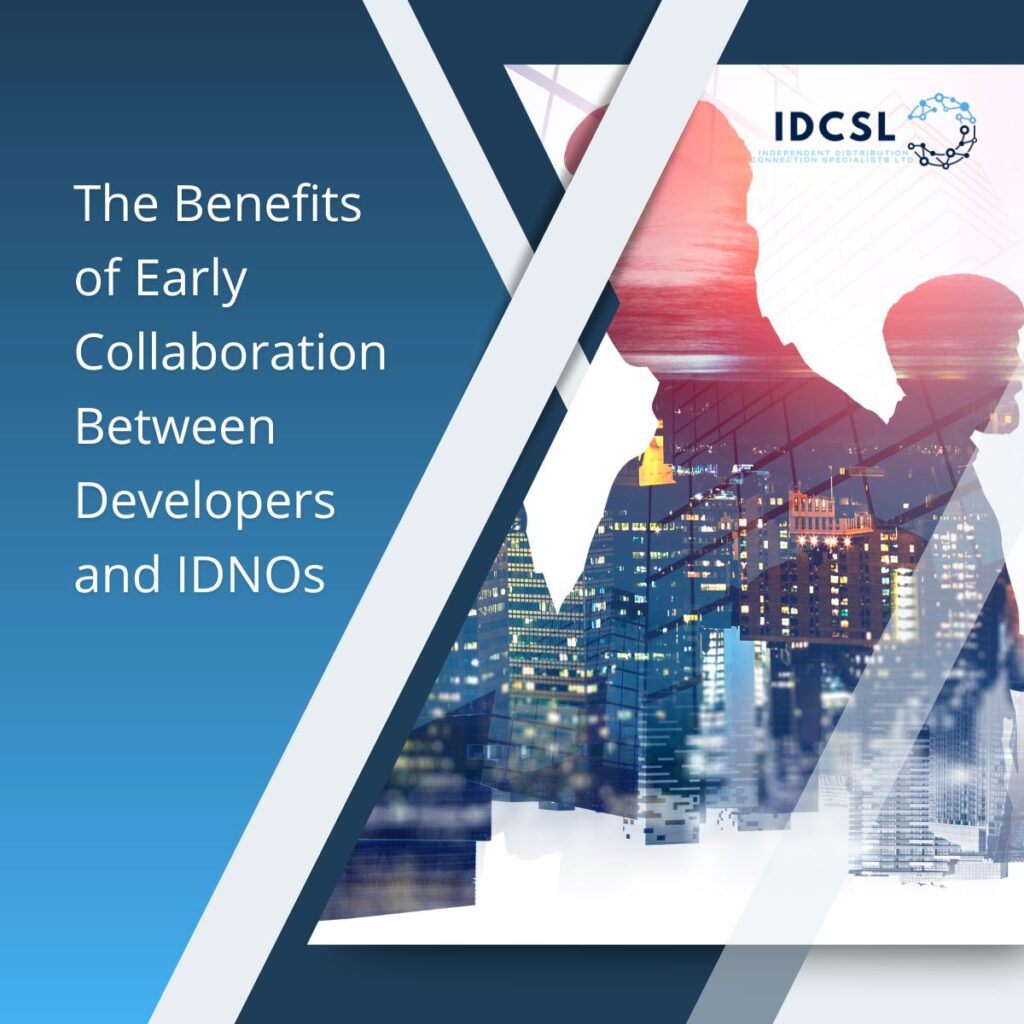
The electricity connection landscape is evolving rapidly. With demand surging from data centres, electric vehicle infrastructure, and renewable energy projects, developers face increasing pressure to deliver projects on time and within budget. Most developers work with established processes: engaging consultants for feasibility studies, tendering connection requirements to Independent Connection Providers (ICPs), and bringing IDNOs into the conversation during the design phase.
These established processes work well, but there’s an opportunity to enhance them further. By introducing IDNO collaboration earlier in the development process, developers can work alongside their existing consultants and contractors to achieve even greater cost certainty, programme assurance, and reduced project risk.
The Traditional Approach and Its Limitations
The conventional connection process typically unfolds like this:
- Developers identify a site
- They secure power capacity
- Then they tender out connection requirements to ICPs and maybe an IDNO at the same time. The IDNO often doesn’t engage until much later in the process.
Sometimes this approach works fine, but it creates several vulnerabilities. Design specifications may not align with adoptable standards, leading to costly variations during construction. If designs aren’t approved to adoptable standards, developers might tender for something and then face variations at the construction end. Without early planning, consent strategies aren’t developed, and long-lead equipment procurement gets delayed because designs aren’t finalised.
The Power of Early Engagement: Cost and Programme Certainty
Introducing an IDNO for early collaboration fundamentally changes the project dynamic.
Design Approval and Standardisation
When IDNOs are involved early, they can provide conceptual approval of designs and equipment specifications. This ensures developers know that their proposed cable route and design specifications meet adoptable standards, resulting in greater cost certainty where design and build contracts align to adoptable standards, locking in pricing without the risk of variations.
Strategic Consent Planning
Early engagement helps with consent strategy development – understanding all stakeholders from the outset. This reveals whether cable easements or substation leases are needed and identifies the effective landowners involved. These processes can then start earlier, allowing appropriate programme and proper sequencing of tasks. Design requirements must be understood before meaningful landowner engagements can commence, and early engagement ensures this happens in the right order.
Programme Acceleration
This collaborative approach can make significant programme improvements, seen through earlier energisations.
Securing Cable Routes: The Statutory Advantage
Modern electricity projects often involve extensive cable routes involving multiple third parties and requiring complex option agreements.
Early IDNO engagement allows developers to leverage statutory undertaker powers effectively. IDNOs can help with cable route planning and use their statutory undertaker’s licence to secure street works permits.
The IDCSL Approach: Collaboration Without Exclusivity
IDCSL takes a new approach. Rather than demanding exclusivity at the outset, the focus is on working collaboratively with developers and their chosen contractors. IDCSL wants to work with development teams and their ICPs on early engagement.
This approach is contractor-agnostic – IDCSL works with all industry Independent Connection Providers (ICPs) accredited through the National Electricity Registration Scheme (NERS). The goal is to establish approved designs, develop consent strategies, and ensure milestones and information are in place where they need to be.
This service targets bigger projects – schemes like data centres or battery storage sites – where the benefits of early engagement are most pronounced.
Asset Value and Investment Benefits
Early collaboration also provides clarity on asset values at an early point in time. IDNOs can give developers early visibility of IDNO investment that can be incorporated into project budgeting, helping with overall financial planning.
Conversations with local authorities and third parties also carry more weight when conducted by an IDNO. These discussions involve networks that will be owned by a statutory provider with the licenses and processes in place to operate and maintain networks, rather than contractors installing private assets.
When Early Collaboration Matters Most
Early engagement becomes particularly valuable for projects with special engineering difficulties – crossing rivers, railway lines, or motorways. It’s also crucial for schemes requiring extensive third-party agreements.
The approach works across all sectors – data centres, battery storage, industrial and commercial developments, and EV charging infrastructure. However, it’s most appropriate for larger schemes where the complexity and scale justify the collaborative approach.
Making Early Collaboration Work
The key to successful early collaboration is starting the conversation when developers have a project and secured power capacity. Early engagement allows IDNOs to work with supply chains to develop land rights strategies, support plant procurement programmes for long-lead items, and ensure design readiness before construction begins.
The focus is on de-risking projects and providing programme certainty rather than over-promising on capabilities. This approach works with existing teams and contractors to create better foundations for project delivery.
Building Strategic Partnerships
Early collaboration represents a shift from traditional transactional relationships to strategic partnerships. Instead of seeing network adoption as the final step, it becomes an integral part of project planning from the beginning.
This approach recognises that successful electricity connections require regulatory knowledge, statutory powers, and strategic planning alongside technical expertise. By bringing these elements together early, developers can focus on their core activities whilst ensuring electrical infrastructure is delivered efficiently and on programme.
The electricity industry’s increasing complexity demands more sophisticated approaches to project delivery. Early collaboration with experienced IDNOs like IDCSL provides the foundation for navigating this complexity successfully, turning potential challenges into competitive advantages through proper planning and strategic partnership.
Ready to explore how early collaboration could benefit your next project? Contact IDCSL to discuss your development plans and discover how early engagement can deliver the cost certainty, programme assurance, and risk reduction your project deserves.
